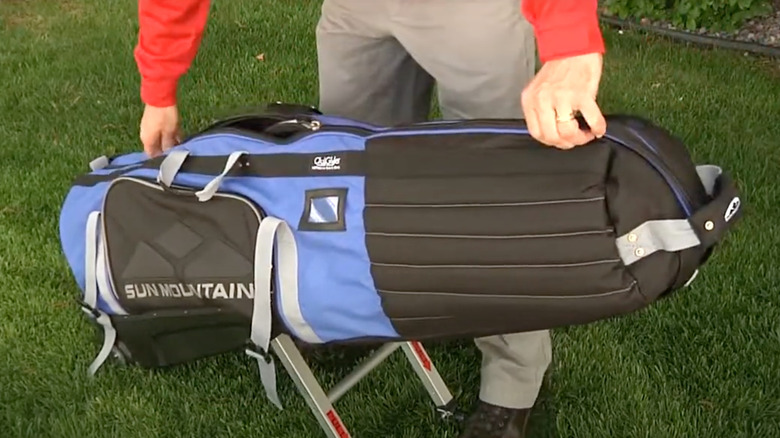What You Need To Know Before Traveling With Golf Clubs
Professional golfer Tom Hoge was dealt quite the blow on April 9 when he picked his golf clubs up from the airport baggage claim after a big trip. "Well, that's a new one @AmericanAir. Thought we just had the standard broken driver today," Hoge tweeted with a picture of a crumpled-up iron on the X platform, formally known as Twitter. Yikes. Fortunately for Hoge, the club was damaged on its way back from the 2023 Masters as opposed to en route for the major golf championship. Either way, though, it's safe to say the experience was disheartening as golf clubs are certainly not cheap, and it generally takes some time to break them in.
Sadly, many golfers are far too familiar with their clubs getting damaged while flying to and from the world's most gorgeous golf courses. "I am in constant fear of my clubs being lost, bludgeoned or generally maimed," golf photographer and writer told The Points Guy in 2019. Fortunately, there are a few ways you can protect your prized sticks while flying high up in the sky.
Hard case? Soft case? Something in between?
If you're flying with your golf clubs, you'll probably want to invest in a quality golf travel bag. However, it should be noted that not all golf travel bags are created equal, hence the great debate between soft and hard shell travel bags. While the golf travel bags designed with a hard cover offer premium protection while traveling, they can also be a pain to lug around and load in the car. Womp, womp, womppp. So who's using them? "They are either CEOs or celebrities who have other people to do the heavy lifting for them," a golf tour operator opined to Golf.com about the particular demographic he's witnessed using the hefty bags. "Or they are the nutty professor types," the operator quipped.
Conversely, their soft-sided counterparts offer much less protection, and many airlines refuse to insure them, ultimately making them less desirable. Fortunately, there's a third option: a hybrid travel golf bag. These bags are typically comprised of primarily soft material, with the top wrapped in a hard shell. A win-win, no?
It should be noted, however, that it's entirely possible to forego a golf travel bag by opting for a golf bag cover instead. A travel golf cover is essentially a padded case (sometimes equipped with wheels for easy maneuvering) that you place your traditional, non-travel golf bag inside. Or you can refuse to travel with your clubs altogether, and ship them instead! The choice is yours!
Pack your clubs with care
Make no mistake — how you pack your clubs is equally important! One way to prevent damage is always traveling with head covers and removing golf club heads when possible. On YouTube, Colby Johannson of GolfersRX recommends that golfers put the shafts in the bag upside down and store the heads in head covers inside the pocket of their golf bag. He also advises golfers to turn all their shafts so they're facing inside the bag and wrap an old towel around them to keep them in place. In the event you're traveling somewhere cold, nix the towels and use your golf sweaters instead.
Unfortunately, as we all know, airlines are notorious for losing luggage ... and yes, even golf clubs. While there's no getting around checking your golf clubs, as the Transportation Security Administration only allows golf clubs as checked luggage, one of the easiest ways to ensure your golf clubs arrive at your destination is by booking a direct flight whenever possible. And when in doubt, throw an Airtag or similar tracking device in your bag for good measure! If your clubs get lost in transport, there won't be any second-guessing their location.


